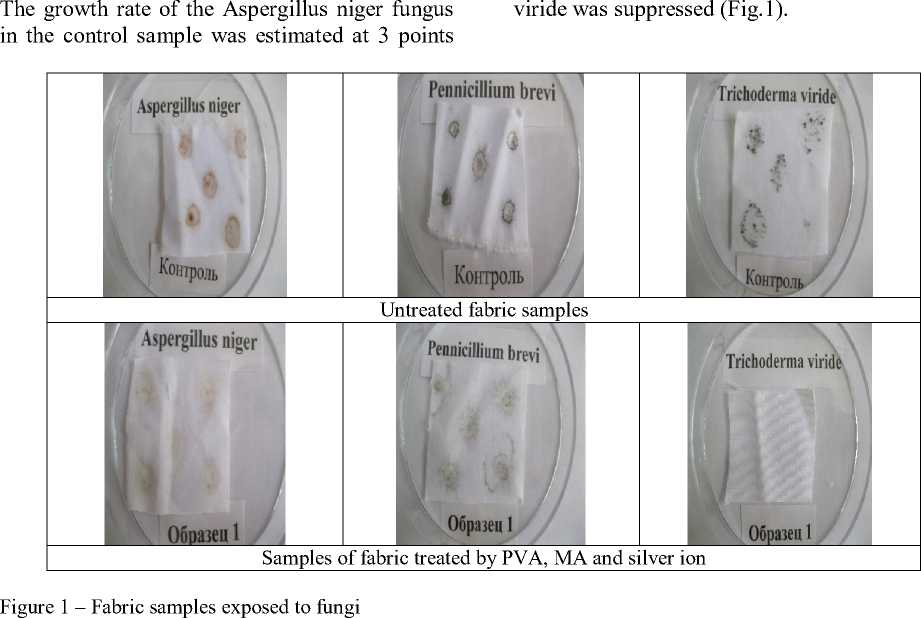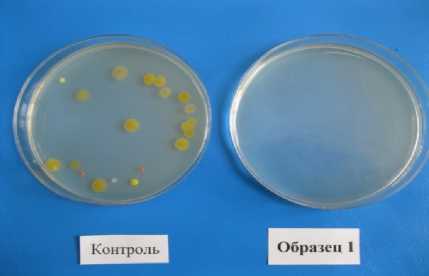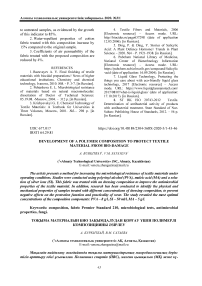Development of a polymer composition to protect textile material from bio-damage
Автор: Burkitbay A., Satayeva V.M.
Журнал: Вестник Алматинского технологического университета @vestnik-atu
Рубрика: Техника и технологии
Статья в выпуске: 3-1 (129), 2020 года.
Бесплатный доступ
The article presents a method for increasing the microbiological resistance of textile materials under operating conditions. Studies were conducted using polyvinyl alcohol (PVA), maleic acid (MA) and a solution of silver ions (SI). This fabric was treated with an dressing composition to improve the antimicrobial properties of the textile material. In addition, research has been conducted to identify the physical and mechanical properties of samples treated with different concentrations of dressing composition, to prevent negative effects on the protection function and practicality of wear. The study revealed the most optimal concentrations of the composition components: PVA - 8 g/l, SI - 50 ml/l, MA - 5 g/l.
Composition, fabric premier standard 210, microbiological tests, antimicrobial properties, fungi
Короткий адрес: https://sciup.org/140256784
IDR: 140256784 | УДК: 677.017 | DOI: 10.48184/2304-568X-2020-3/1-43-46
Текст научной статьи Development of a polymer composition to protect textile material from bio-damage
Typical requirements for standard employee's work wear are usually reduced to ensuring its protective functions and practicality of wear. In recent years, the question has arisen of the need to create completely new materials necessary for special clothing. Certain substances and finishing methods are used to give certain properties.
Due to the huge material losses caused by the action of microorganisms, at the moment, more attention is paid to the biosecurity of various materials, including textiles, which are damaged during their production, storage and operation [1].
Materials and research methods
Laboratory studies were conducted using physical, mechanical, and microbiological testing methods.
The main objects of research in this work were:
-
- fabric Premier Standard 210 (article 81423);
-
- chemical compounds: polyvinyl alcohol, maleic acid, silver ion solution.
Results and their discussion
We have conducted research on the development of a composition for sizing mixed fabrics in order to improve the antimicrobial properties of textile materials under operating conditions. Maleic acid (MA), polyvinyl alcohol (PVA) and a solution of silver ions (SI) were taken in the composition of the sizing composition.
A fabric sample of 20 × 20 cm it was treated with an aqueous solution of polymer compositions of various concentrations [2]. Concentrations are shown in table 1.
Microbiological studies were performed on untreated and treated samples of mixed fabric [3]. Aspergillus niger, Penicillium brevi and Trichoderma viride fungi were used as test cultures to test for fungal resistance.
The tissue samples under study were infected with a fungi suspension and transferred to Petri dishes. Next, Petri dishes were placed in a desiccator with water. The desiccator with water was used to provide the necessary humidity. Incubation was carried out for 28 days at a temperature of 30℃ [4]
As a result, after 28 days, the growth of Penicillium brevi and Trichoderma viride fungi was detected on the untreated tissue sample. The intensity of fungal germination was 5 points (noticeably extensive tissue damage by fungi).
(noticeable growth, but not over the entire surface of infection).
The growth of Penicillium brevi and Aspergillus niger fungi was observed on the fabric samples treated with this composition, but the intensity of their germination was insignificant, and the growth of Trichoderma

The contamination of fabric samples was also investigated. For verification, swabs were taken from fabric samples. Swabs were taken using sterile moistened cotton swabs. Before seeding the washings, 5 ml of an isotonic sodium chloride solution was added to the swab. The tampon was washed thoroughly, after which 0.1 ml of flushing fluid was placed in a Petri dish with nutrient medium. The cups were placed in a thermostat at 30°C. A preliminary count of the grown colonies was made after 48 hours, the final - after 72 hours [5].
As a result of research, it was found that the growth of bacteria in cups containing flushes from untreated tissue samples significantly increased. On the surface of untreated mixed fabric (25 cm2) contains about 200 cells. In the treated fabric samples, microbial growth was absent (Fig. 2).

Figure 2 - Bacterial growth from flushing from untreated and treated mixed fabric samples
Quality assessment of finished fabrics was carried out on the physico-mechanical properties such as crease-resistance, tensile characteristics and abrasion resistance as well as organoleptically.
As a result of the assessment on organoleptic indicators, it was found that the fabric becomes smooth and easily slips off the hands.
Table 1 – Physic and mechanical properties of Premier Standard 210 fabric
|
№ |
Component concentration |
Total angle of opening of folds, (°) |
Breaking load (based on), N |
Air permeability, dm3/ m2×s |
||
|
PVA, g/l |
SI, ml/l |
MA, g/l |
||||
|
1 |
8 |
100 |
5 |
160 |
372 |
35,5 |
|
2 |
4 |
100 |
5 |
165 |
377 |
33,6 |
|
3 |
8 |
50 |
1 |
178 |
394 |
34,3 |
|
4 |
4 |
50 |
5 |
168 |
405 |
33,5 |
|
5 |
8 |
100 |
1 |
158 |
390 |
35,4 |
|
6 |
4 |
100 |
1 |
159 |
421 |
35,1 |
|
7 |
8 |
50 |
5 |
171 |
499 |
35,8 |
|
8 |
4 |
50 |
1 |
180 |
367 |
35,9 |
|
Average index |
- |
- |
- |
167 |
403 |
34,8 |
|
The untreated fabric |
- |
- |
- |
114 |
330 |
33,5 |
Список литературы Development of a polymer composition to protect textile material from bio-damage
- Razuvaev A.V. Final finishing of textile materials with biocidal preparations. News of higher educational institutions. Chemistry and chemical technology. Ivanovo, 2010, vol. 53, issue 8.-Р. 3-7.
- Encyclopedia of polymers. Editorial Board: chief editor V.A. Kabanov and others. - M.: "Soviet encyclopedia", 1974. - Vol. 2. - 1032 p.
- State standard 9.048-89 Methods of laboratory tests for resistance exposure to mold fungi. - Introd. 1991-07-01. - M.: State standard of the USSR union: Standards Publishing House, 1989. -23 p..
- Kutzhanova A.Zh., Tausarova B.R., Burkitbay A. Giving antimicrobial properties to cellulose textile materials. / Materials of the International scientific and technical conference "Food and light industry in the strategy of entering the Republic of Kazakhstan among the 50 most competitive countries in the world". - Almaty, ATU, 2007. - P. 216-218.
- Prozorkina H.V., Rubashkina P.A. Fundamentals of Microbiology, Virology and immunology: textbook, 4th ed. - Rostov-on-don 2006. - 380 p.


